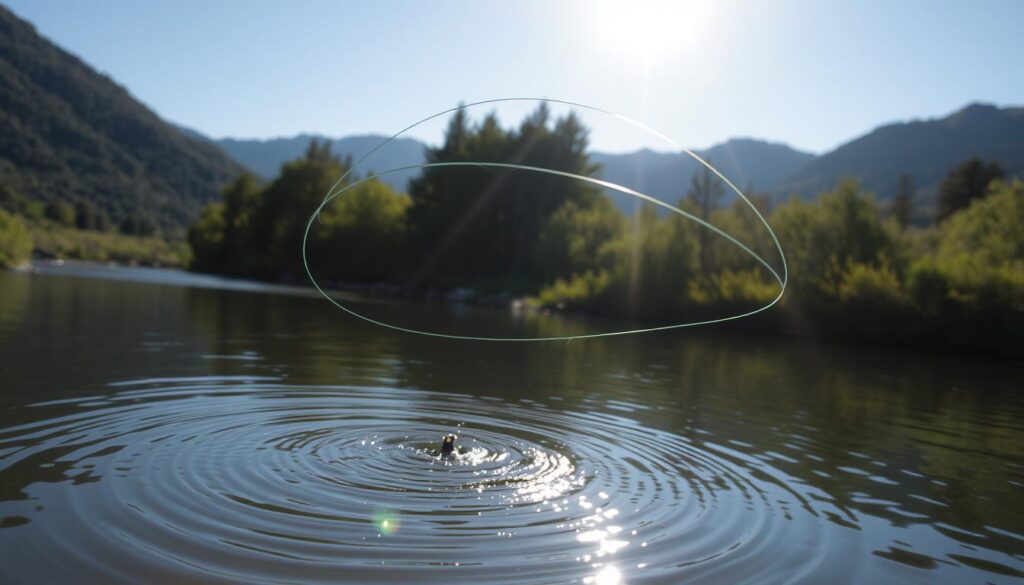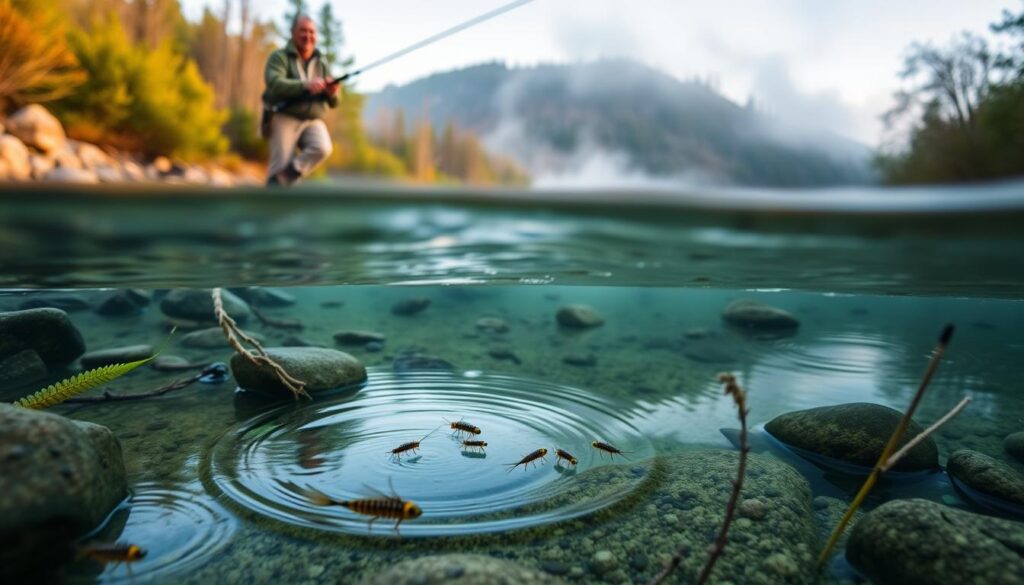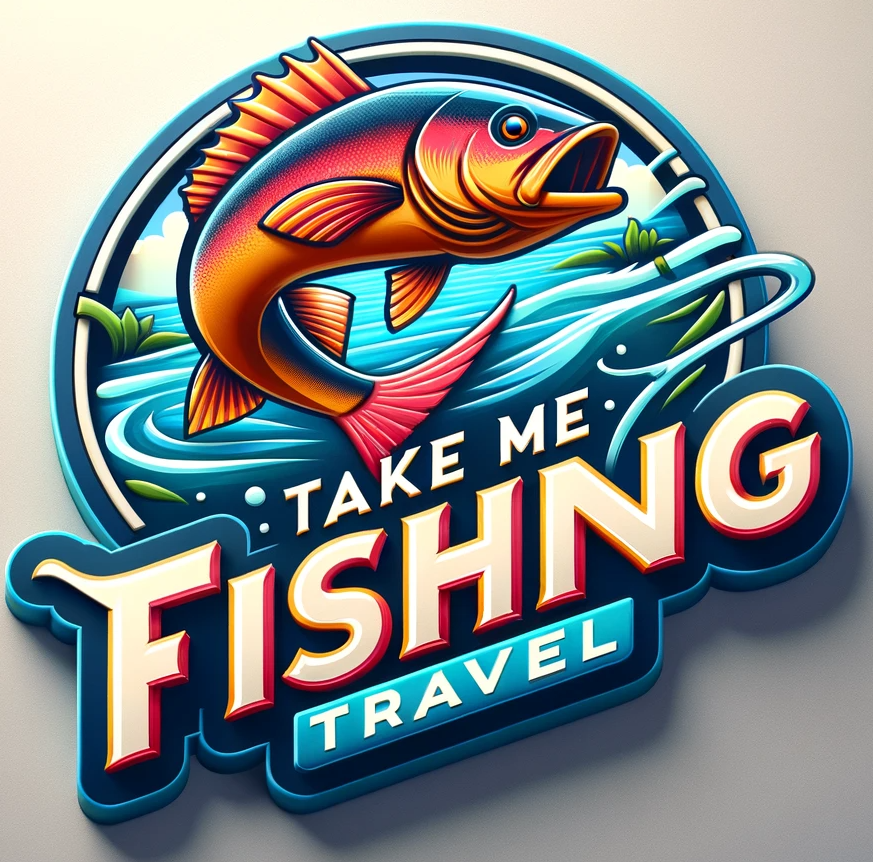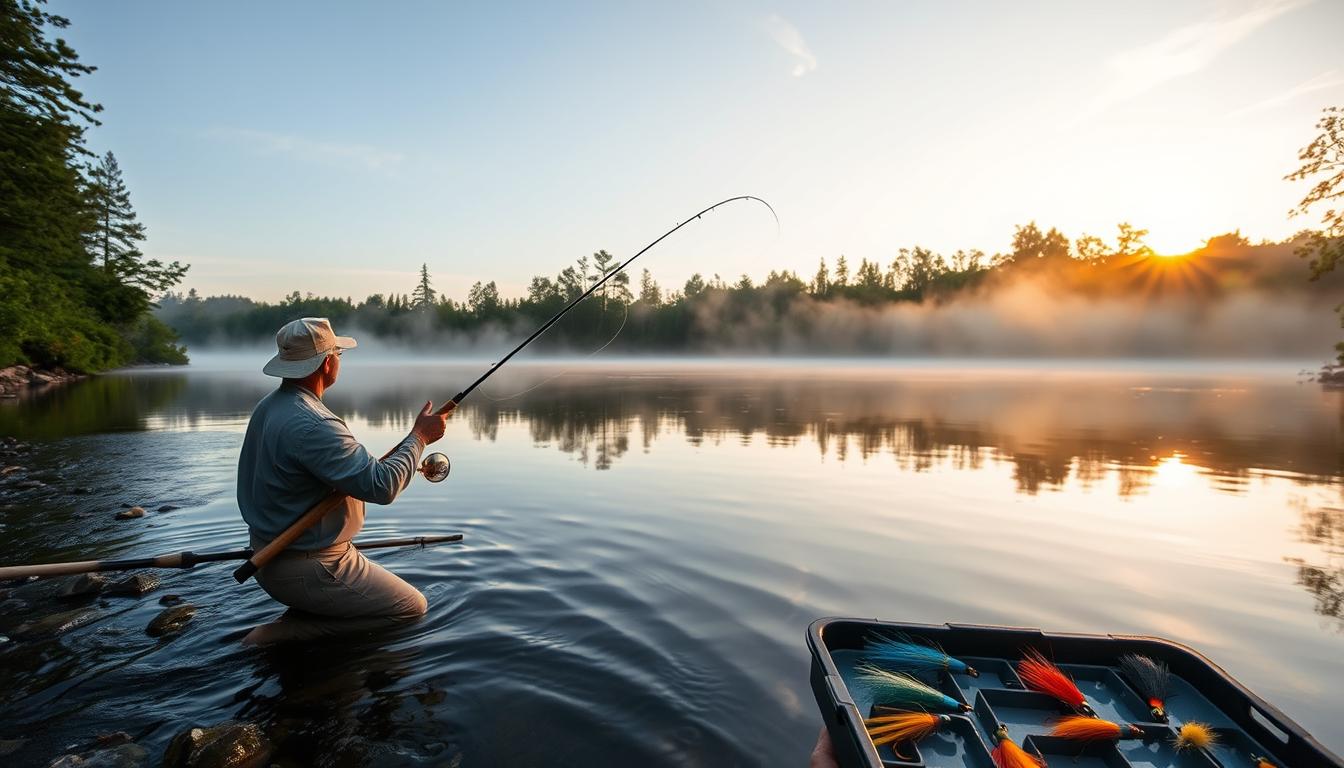This post contains affiliate links.
Imagine standing knee-deep in a clear stream, nature’s untouched beauty all around. This setting can make life’s stress fade away. If you’ve felt the excitement of a trout leaping for your fly, you know fly fishing’s magic. Fly fishing techniques are more than an art. They are a dance with the water, a journey of learning and getting better.
Many remember their first time holding a fly rod fondly, with warmth and nostalgia. The sunlight on the water, the soothing rhythm of casting, and the joy of catching your first fish. This passion motivates us to improve our skills, try new techniques, and master our craft. It doesn’t matter if you’re starting out or have years of fishing behind you. Learning the basics is essential.
In Tasmania, known for its excellent trout fishing, anglers chase wild brown and rainbow trout in beautiful rivers, lakes, and streams. Taking time to learn, getting advice, or hiring a guide like Trout Tales Tasmania can be a game-changer. They provide personalized tours, share priceless advice, and insider tips.
For beginners, a setup like a 6-weight Stalker with a floating fly line is recommended. With it, you can start basic fly fishing confidently. Trout Tales offers key casting tips: the 10-2 arc, wrist control, and the importance of pausing. These can greatly improve your technique. They also offer a discount at Hurleys Fly Fishing. Just use the code Trout Tales. This, along with local anglers’ support, helps you progress from a beginner to a pro.
Key Takeaways
- Fly fishing lets you connect deeply with nature, enhancing your enjoyment and technique over time.
- Tasmania offers world-renowned trout fishing opportunities for both beginners and seasoned anglers.
- A 6-weight Stalker setup with a floating fly line is ideal for learning how to fly fish for trout effectively.
- Trout Tales Tasmania provides invaluable guided tours and expert tips for mastering fly fishing techniques.
- Employing precise casting techniques, such as the 10-2 arc and wrist control, can significantly improve your fly casting skills.
- Utilize local resources, discounts, and community knowledge to gear up and dive into the art of fly fishing with confidence.
Essential Gear and Setup for Fly Fishing
Starting fly fishing might seem challenging for newbies. But don’t worry, experienced fishermen! With the correct equipment, you’ll be fishing like a pro very soon. Let’s look at the basic gear to begin your journey.
Choosing the Right Fly Rod and Reel
Choosing the right rod and reel is key to enjoying fly fishing. A good start for beginners is a 9-foot 5-weight rod with medium action. The Reddington Crosswater Combo is a popular choice. Fly rods vary in weight, length, and parts, so pick carefully.
Reels should match your rod’s weight. Large arbor reels are best because they retrieve lines fast. Opt for reels with solid drag systems for easier handling of fish. Sealed disc drags are excellent for the ocean, keeping out saltwater damage.
Selecting the Proper Line, Leaders, and Tippets
Your line should fit the rod’s weight to work best. Scientific Anglers offer good value floating lines. Beginners should try a 9.5 ft 5x tapered leader, like the Rio Suppleflex Trout pack. It helps with smooth casting. Tippets are crucial too; the Rio Powerflex Tippet pack is good for dry flies. Specific fishing methods might need different lines and leaders for best results.
Must-Have Flies and Accessories
Flies are essential for your trip. Start with 4-6 kinds of dry and wet flies, such as the Parachute Adams and Elk Hair Caddis. You’ll also need nippers, hemostats, and floatant for the flies. Wearing a fishing vest or chest pack helps you reach your gear easily while fishing.
If you’re not ready to buy all the gear, consider renting or getting a combo pack with a return policy. Fly fishing is both an art and a science. With the right equipment, you’ll quickly get the hang of it. Tight lines everyone!
Basic Fly Casting Techniques
The art of fly casting involves key techniques at its core. These are essential for anyone starting in fishing. Practicing in spaces like your backyard is a good start. It’s also important to use the right gear and sharp hooks.
Mastering the Overhead Cast
The Overhead Cast is basic but very important. It’s great for beginners to learn first. Imagine making a smooth move, stopping the rod high to form a tight loop. It’s good to have a friend watch and give tips.
Perfecting the Roll Cast
The Roll Cast works well when space is tight. It uses water to help make the cast. Trying different hand positions can change how it works. This cast gets better with patience and practice.
Understanding the Forward and Backcast
Knowing how to manage the back and forward cast is key. It helps in making your fly land just right. Using your hand to control the line helps. Watching videos can show ways to improve.

| Fly Casting Technique | Key Benefits | Recommended For |
|---|---|---|
| Overhead Cast | Creates tight loops | Beginners |
| Roll Cast | Useful in tight spaces | Intermediate |
| Forward and Backcast | Accurate presentation | Advanced |
| Bow and Arrow Cast | Targets difficult areas | Technical anglers |
| Double Haul Cast | Long-distance casting | Saltwater fishing |
Adopting these fishing techniques will improve your skills. Focusing on controlling your loops and learning different casts is crucial. This will guide you towards becoming successful at fly casting.
Fly Presentation Techniques
Getting good at fly presentation techniques is a must for anglers wanting to trick fish. Whether you’re experienced or new to fly fishing, learning these techniques will improve your skills. They make your fly look like a natural insect, which is hard for fish to resist.
Dead Drifting
Dead drifting is a top fishing technique that copies how insects drift in water. You keep the fly floating without dragging, making it look like natural prey. It’s simple yet effective and needs careful attention and right placement in the water.
Tight-Line Fishing
Tight-line fishing is great for anglers who prefer feeling bites directly. It differs from dead drifting, keeping the line tight for more strike control. Mainly used in euro-nymphing, it’s best in deeper or faster waters for better fly control.
The Art of Swinging
Swinging moves the fly in a wide arc, matching an insect’s struggle against the current. This attracts predatory fish. It resembles a dance on water, balancing control with seeming natural.
| Fly Presentation Technique | Main Advantage | Optimal Conditions |
|---|---|---|
| Dead Drifting | Natural Look | Calm Waters |
| Tight-Line Fishing | Direct Feedback | Fast Currents |
| Swinging | Broad Coverage | Mid to Large Rivers |
Varying your fly presentation techniques, from dead drifting to swinging, suits different water types and fish behaviors. Trying out different approaches adds to your skills, making fishing more fruitful and enjoyable. Knowing how to mimic fishing techniques makes your fly more realistic, giving you an edge in fishing.
Understanding Nymphing
Anglers often use nymphing to catch fish below the surface. Since most of a fish’s diet is eaten underwater, learning this method can greatly increase your catch. We will explore choosing the correct nymphs, effectively using strike indicators, and noticing those barely-there strikes that matter most.

Choosing the Right Nymphs
Selecting the right nymphs means knowing about local bugs and what fish like. Your flies should look like real underwater insects to attract fish. Euro nymphing, a specific style, uses heavy nymphs without extra weights or floaters for deeper and better-controlled fishing. Remember to check the rules since some places allow using 2-3 fake flies on one line.
Using Strike Indicators
Strike indicators are key for spotting light bites, especially near the bottom. To not scare the fish, set the indicator at 1.5 to 2 times the water’s depth. This helps your fly look natural by drifting freely. Tight-line nymphing, with its short casts, also helps in feeling bites better.
Detecting Subtle Strikes
Noticing subtle bites is a skill on its own. Sometimes, trout only move a bit to take a fly, never more than eight inches up. Nymph fishing in shallow places without indicators can work well, especially with hungry fish. The wet-fly swing, good for gentle to moderate flows, works well in certain areas. For deeper understanding, take a look at the best fishing times.
Whether you stick with classic nymphs, try new fishing methods, or focus on detecting strikes, knowing these aspects will make your fishing better.
The Art of Dry Fly Fishing
Dry fly fishing is viewed as a top achievement in the sport. It uses flies that stay on top of the water. This method seems simple but is very rewarding. To do well, you need to pick the right floating flies, copy the insects on the water, and perfect your timing.
Choosing Buoyant Flies
Picking the right flies is key in dry fly fishing. These flies look like insects at different life stages on the water. You might use flies that mimic caddis flies, mayflies, and others. The goal is to match your fly with the insects in the area. You can use a mixture of white gas and wax to keep your flies floating longer.
Mimicking Surface Insects
Your success depends on how well you can imitate surface insects. You must watch the water and know when insects hatch. For example, stoneflies have a special way of living. They crawl on the riverbed before showing up near the banks. Watching insect behavior helps you pick the right fly and how to show it, raising your catch chances.
Timing Your Presentation
In dry fly fishing, timing your cast is crucial. Great fishermen cast their lines to match when fish are feeding. They use special casts like the reach cast to keep the fly drifting naturally. These techniques are important to look natural and not scare the fish. Adjusting your timing with the water temperature and insect activity improves your fishing.
Techniques for Streamer Fishing
Streamer fishing is now more popular with those wanting to catch big predatory fish. Fish like brown trout, bass, and pike. It’s exciting because it simulates baitfish, causing fish to strike instinctively.
It’s key to change fishing techniques based on the water and fish. Before trying new waters, anglers set up their gear. A top setup includes a 9 ft fly rod, weight 7 or 8, with a sink tip fly line. Use thicker tippet sizes (0X – 3X) for big flies and fish.
| Recommended Streamer Flies | Characteristics |
|---|---|
| Coffey’s Sparkle Minnow | High flash, moderate weight |
| GD Scalp Snack | Heavy, sculpin imitation |
| Strolis’s Headbanger Sculpin | Dense, ideal for deeper waters |
| Lynch’s Drunk & Disorderly | Erratic action, attractive to large predators |
| Ford’s Laser Pup | Sleek profile, versatile |
Changing your streamer’s weight, shape, and size matters a lot. Streamers like the Game Changer keep moving, even when still. This works great for tricking baitfish and smart predatory fish.
Streamer fishing in Missoula, MT suits high, murky waters. A setup with skinny line, long leader, and the right streamer works well. Missoula fly shops have lots of streamers for different fish.
Try new streamer colors every 15 minutes if no fish bite. Changing how you reel in based on trout behavior helps too. At night, black streamers are good for catching big brown trout.
Fall is a great time for streamer fishing, but it works all year. The first two weeks of October are usually best. Big fish like streamers that move naturally, like real baitfish.
Being prepared is key for fishing. Bring gear like a 6wt rod and thick tippet for large or toothy fish. Check out this packing guide for a detailed list.
So, grab your gear and enjoy streamer fishing. Remember to adapt your approach to win!
Reading the Water and Fish Behavior
Learning to read the water can really up your fly fishing game. Fish follow set patterns, and knowing these can lead you to the best fishing spots. Let’s explore how to find these spots, understand where fish like to hang out, and adjust to different water conditions.
Identifying Prime Fishing Locations
Fish in streams and rivers look for two things: shelter and food. The best spots often have undercut banks where big bass and trout live. These places offer good food sources and protection. Also, look for where fast and slow water meet. Fish like these spots because they can rest and grab food without much effort.
Understanding Fish Habitats
Fish homes change with the water temperature. In cold water, they prefer deep, slow areas to conserve energy. But in warm months, trout seek out riffles and fast-moving water. Knowing these patterns helps you pick the right fishing approach. Trout, for example, often feed at the upstream end of a pool, then rest at the downstream end.
Adapting to Water Conditions
Changing your fishing strategy with the water conditions is key. Water level, temperature, and clarity all influence fish behavior and eating habits. When it gets hot, fishing in spots with lots of oxygen, like riffles, is smart. In the spring, when the water is high, try fishing in protected spots like eddies. For more tips on how weather impacts fishing, visit this guide.
Knowing good fishing techniques and how water moves can turn an okay fishing trip into an amazing one. Always watch the water closely, be ready to change how you fish, and follow safety tips to make your time at the water better.
The Importance of Entomology in Fly Fishing
Entomology is key in fly fishing. It helps anglers understand how aquatic insects behave and live. This knowledge is crucial for choosing the right fly patterns. It leads to more successful fishing trips.
Studying Aquatic Insects
Important insect orders in trout streams and lakes include mayflies (Ephemeroptera), caddisflies (Trichoptera), midges (Diptera), and stoneflies (Plecoptera). Knowing these insects and their life stages is essential. For a mayfly, this means understanding its nymph, dun, and spinner stages.
Recognizing these stages helps anglers know when fish are likely to feed. This insight is vital during insect hatches.
Matching the Hatch
Matching the hatch means using flies that look like the insects fish are eating. Sometimes, trout will choose mayfly nymphs during their rise. This shows they prefer nymphs that float. By matching the hatch, anglers see more strikes and enjoy fishing more. Learn more about effective fly patterns and fishing
Using Insect Behavior to Your Advantage
Knowing insect behavior is as crucial as understanding their lifecycle. During a mayfly emergence, nymphs swim up to molt into duns. This makes them easy targets for fish. Choosing the right fly patterns during this time is key.
Knowing the main features of mayflies, caddisflies, midges, and stoneflies helps too. For example, mayflies have sailboat-like wings. Recognizing these features helps in choosing the right fishing approach. This leads to better success on the water.
| Order | Common Name | Lifecycle Stages |
|---|---|---|
| Ephemeroptera | Mayflies | Egg, Nymph, Dun, Spinner |
| Trichoptera | Caddisflies | Egg, Larva, Pupa, Adult |
| Diptera | Midges | Egg, Larva, Pupa, Adult |
| Plecoptera | Stoneflies | Egg, Nymph, Adult |
Using entomology makes you better at matching the hatch. It helps you use techniques that imitate what aquatic insects do. This increases your chances of catching fish. Knowing about entomology means you’re mastering fly fishing.
Conclusion
Fly fishing is more than catching fish. It’s about learning the right techniques and gear, and knowing the environment. You need to know about the gear, like the rods, and techniques like the roll and water haul casts. Casting correctly using your wrist and arm is basic but essential.
Mastering skills like false casting and double haul casting helps with distance and precision. But, there’s more to it than just technique. It’s about reading rivers, understanding fish, and knowing where they live. Whether you’re after trout in cold water or bass in warm water, you need the right setup.
Fly fishing is also about protecting nature and supporting conservation. Its history, dating back to England’s reservoir stockings and books like The Compleat Angler, shows its significance. It’s a chance to help conserve nature for future anglers. Every cast we make can contribute to preserving our precious waterways and fish habitats.
FAQ
What are the basics I need to start fly fishing?
How should I practice my fly casting techniques?
Which fly presentation techniques are most effective?
What should I know about nymphing in fly fishing?
How can I get better at dry fly fishing?
What’s the best approach for streamer fishing?
How do I read the water and understand fish behavior?
Why is entomology important in fly fishing?
This post contains affiliate links.

